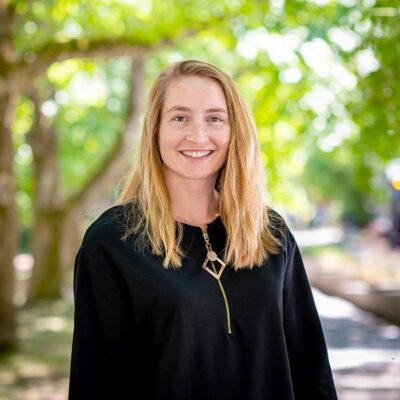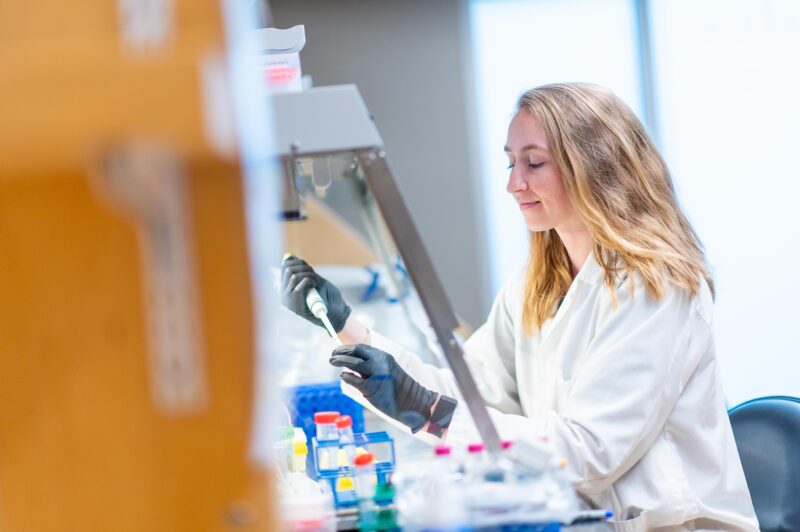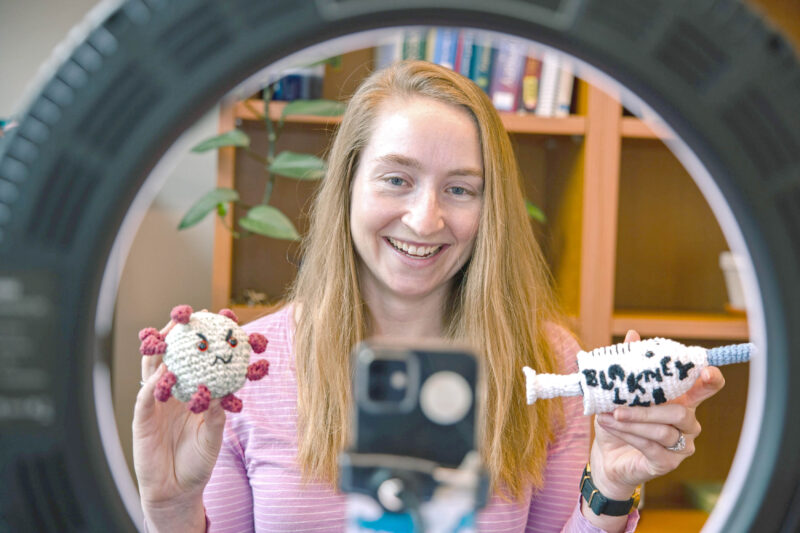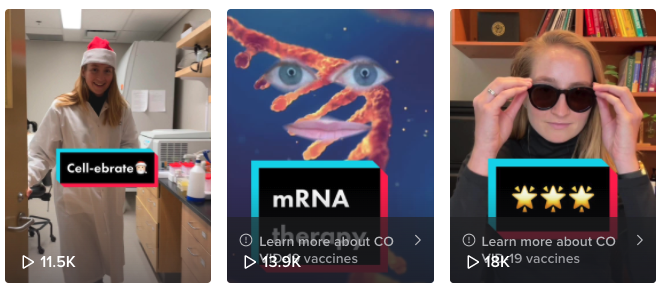Awards and recognition
Dr. Anna Blakney receives UBC President’s Award for Public Education Through Media
 Dr. Anna Blakney (she/her) was recently honoured with the UBC President’s Award for Public Education Through Media for her extensive outreach and engagement activities educating the public about vaccines and mRNA technologies on social media. Building an impressive audience of more than 270,000 TikTok followers over the last 18 months, Dr. Blakney is an unlikely social media influencer.
Dr. Anna Blakney (she/her) was recently honoured with the UBC President’s Award for Public Education Through Media for her extensive outreach and engagement activities educating the public about vaccines and mRNA technologies on social media. Building an impressive audience of more than 270,000 TikTok followers over the last 18 months, Dr. Blakney is an unlikely social media influencer.
“I am hugely honoured to receive this award. There have been so many exceptional efforts by the UBC science community working hard to communicate the latest data, discussing variants and other details of the pandemic over the last two years. Science communication has become a critical tool. But I never imagined I would be rewarded academically for making TikTok videos. It’s wonderful to see that science communication via social media is really valued by the university,” says Blakney.
Seizing the science communication opportunity
Having only used social media for personal posts prior to the pandemic, Blakney was intrigued when she was approached by Team Halo to join their social outreach campaign back in October 2020. Finishing her postdoctoral studies at Imperial College London in England, Blakney was honing her skills as an expert in mRNA vaccine technologies. Team Halo, a collaboration between the UN Verified initiative and the Vaccine Confidence Project, aimed to boost vaccine education and confidence amidst the worsening global COVID-19 pandemic. They were seeking out expert scientists to help educate the global public. Leveraging the expansive platform of social media for science communication was a golden opportunity.
“When else have I had an audience of 270,00 people? Having that reach is an incredible opportunity,” Blakney reflects.
Suddenly Blakney’s media skills producing travelog style home videos for her family vacations would be put to the test. Although her previous experience with educational outreach centered around conference presentations and teaching classes, specialized groups of people she engaged deeply with, the broad audience layperson on social media presented a new challenge. Also aware of the global reach of this platform, she aimed to create content that communicated across cultures.
“One of the biggest takeaways from this experience is how to communicate my science to a broader audience. TikTok is everything and everyone.”
Blakney dove into shooting and editing educational videos describing mRNA vaccine development. Used to developing hour long lectures, her biggest challenges were distilling the content down to the bite sized, 15-second clips that TikTok required.
“The most important thing to keep in mind when creating content is the hook, the very beginning of the video. You need to be able to grab people’s attention immediately and engage them right away. They want to know what to expect from the first few seconds,” says Blakney.
Scientists are humans too
She quickly learned that the most effective videos were sometimes the most raw. With each social media platform having its own flavour and audience, Blakney discovered TikTok users are often in search of humourous and authentic content, eager to get a glimpse of the personality behind the camera. Not only does she share scientific findings and evidence with her followers, but she also takes people behind the scenes into her lab. She often riffs off trending meme videos that overlay the same snappy audio samples on top of original video content. The best way to reach new potential followers is through popular content that everyone is scrolling through.
“I think this is why my account has done well. People have this stereotype of scientists as being these stodgy, serious figures. Bringing some humour and authenticity to my videos allows people to remember that scientists are just humans too,” reflects Blakney.
This relatability is perhaps something that will help build up the trust and confidence in science that Blakney and others are aiming to promote at a crucial time when much misinformation is being shared. Wanting to put more faces to names, Blakney created content with science heavyweights like lipid nanoparticle godfather Dr. Pieter Cullis and Moderna co-founder Bob Langer. She has participated in traditional media with various print, TV and radio interviews, as well as newer forums like Reddit’s AMA (Ask Me Anything) series. Embracing this diversity of platforms, Blakney continues to push the envelope of what science communication encompasses. After the wild success of her TikTok debut, she is now focused on developing longer format videos for her burgeoning Youtube channel, a great place to park more complex educational pieces that build on her shorter videos.
“Come for the entertainment but stay for the science,” she laughs.
Prior to the pandemic there seemed to be very few scientists on social media sharing their knowledge. Scientists were less accessible. But the past two years have transformed the way we get our factual information. Embracing social media as a way to disseminate important scientific findings also means gleaning through the comments section. Blakney has received both positive and negative feedback to her posts, but she focuses on the repeated questions and misinformation she finds in the comments to inform her content production. She aims to strike a balance between catering to her followers’ queries and engaging with a constantly changing audience.
Advice for social media newbies
Creating content for science communication on social media can be a daunting task. Scripting videos, shooting and editing, building up followers, responding to online interactions, all of this takes time and practice. But the effort can be rewarding when important information and scientific findings have the potential to reach a broad, global audience.
“Prior to January 2020, very few scientists were aware of RNA vaccines, let alone the general public. Now millions of people have received them. It didn’t just happen overnight; it took decades of research. But the pace we communicate to the public with is so much slower than the pace of research. Social media allows us to close that gap between what’s happening in the lab and what the public actually knows about.”
Motivated by this, Blakney encourages others in her field and STEM at large to get involved.
“I want more comrades. I’d love for there to be more scientists on TikTok and other social media platforms. It helps spark interest for people considering careers in science and showcases all the different types of science out there to participate in.”
Blankey’s advice to other scientists looking to start sharing their expertise on social media: start with a single platform. Each has their own flavour and audience, so you need to produce for the platform. Pick one that resonates with you and test your content there. Be yourself, pay attention to your followers, the comments, and remember not to take it all too seriously. Engaging with your audience can be more impactful than how many views and followers you have. And remember to have fun.
Dr. Blakney’s passion for science education is infectious. Her dedication to crafting engaging content for broad audiences and combatting misinformation is commendable. We can’t wait to see where her creativity takes her and what more we might learn from her efforts. Please join us in congratulating Dr. Blakney on her much-deserved recognition with this award.


